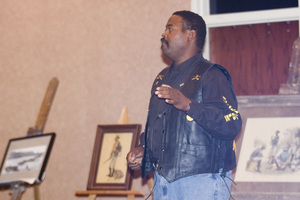Speaker tells about Buffalo Soldiers

The Buffalo Soldiers may not have been charged with the most noble of the U.S. military's duties, but they still deserve a great deal of respect.
That was the message of Derek Goodwin, a Chadron teacher and historian, who on Tuesday told an audience at Chadron State College about the lives of the the black men of the 9th and 10th Cavalry who were stationed at Fort Robinson around a century ago. About 150 people attended the presentation in CSC’s Student Center.
Beginning with the first black graduates of the United State Military Academy, Goodwin told about the discrimination and hardships black soldiers faced during their service in the late 1800s and early 1900s.
West Point’s first black graduate, Henry O. Flipper, was dishonorably discharged after four years of service, Goodwin said. Although official records indicated that Flipper, a lieutenant, embezzled payroll funds, history later revealed that the officer came at odds with fellow servicemen after he went riding with a young white woman. Flipper’s family and other supporters succeeded in having the late officer exonerated of the embezzlement charges, but not until the late 1900s.
Although the soldiers of the 9th and 10th were given the task of carrying out the U.S. military’s controversial mission to remove American Indians from the Plains, Goodwin said he does not view the soldiers as dishonorable people. He said most of the soldiers lacked training to succeed in the civilian work force, so the military was one of just a limited number of ways for them to make a living.
“I’m not by any means claiming that these guys were heroes,” Goodwin said. “But, you’ve got to remember that, back then, $13 a month was a lot of money. The military was a great option for them to make a little money and have a place to call home.”
Goodwin noted that the predominantly white 7th Cavalry had more desertions in one year than the 9th and 10th had during their entire history. He said that statistic resulted more from the Buffalo Soldiers’ limited career choices than commitment to the military’s cause.
“There was nothing else for them to do,” he said.
Goodwin also told about the only woman Buffalo Soldier, Cathy Williams, who enlisted as a cook in 1866 using the name William Cathay. Despite 13 recorded visits to military doctors, it was never noted in medical records or other documents that Williams was female, and she passed as a man during her entire two years of service. She was later discharged from the military for health reasons.
“That tells you a lot about the type of medical service these guys were receiving,” Goodwin said.
Goodwin, who referred to artwork and photographs that lined the wall during his presentation, has collected more than 20 large pieces that portray Buffalo Soldiers. He first became interested studying the black soldiers after leading Pine Ridge Job Corps students during Fort Robinson field trips, he said.
While researching, Goodwin befriended veteran Buffalo Soldier William Bailey of Whitney, who died at the Veterans Administration Hospital of Hot Springs, S.D., less than a decade ago. Before death, the soldier gave Goodwin a set of spurs he used during his military service.
Tuesday’s program was the second installment of the bi-weekly Dorset Graves Lecture Series sponsored by CSC’s Reta King Library. On Tuesday, Oct. 23, Mary Donahue, CSC art professor, will present “Following Cairns: An Artist’s Journey with Rock and Time.”
Category: Campus News
